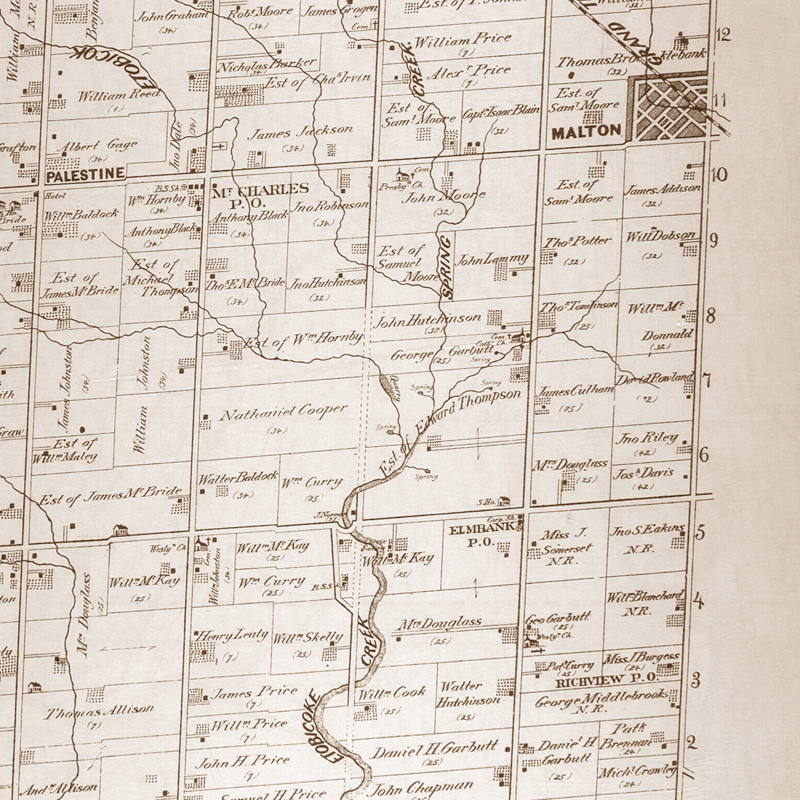- Home
- Our Community
-
Offices & Ministries
- Administrative Offices (A-N)
-
Administrative Offices (O-Z)
- Planning, Properties & Housing
- Public Relations & Communications
- Research
-
Spiritual Affairs
- Home
- Churches and Ecclesial Communities with valid Baptism
- Registration Forms for Baptism, First Holy Communion, Confirmation, and RCIA
- Marriage Preparation
- Celebration of Holy Mass Outside of a Sacred Space Protocol
- Exorcism Protocol
- Healing Service Protocol
- Visiting Clergy-Laity Protocol
- Selected Pastoral Notes on Sacraments and Sacramentals
- Faculties for Clergy
- Temporal Affairs
- Western Bishops Office
- Volunteer Screening
- Pastoral Ministries
- Social Justice & Outreach
- Our Faith
- Outreach
- Contact Us
- Search

History of Elmbank Cemetery
In the early 1800s, the first Europeans arrived in Toronto Township, County of Peel, in search of a place to raise their families and make a decent living. Very fertile farmland attracted the early settlers to the area that now encompasses parts of Brampton, Mississauga, and Etobicoke. This settlement permitted the erection of productive farms raising livestock (cattle, horses, sheep and hogs) and the export of grain overseas to England. In 1818, land was acquired from the Mississauga Aboriginal People in order to accommodate the influx of immigrants. In 1819 the first settlers of the Malton area began the establishment of farming communities.
Catholics were among the early population and they would rapidly unite to form the first congregations of Toronto Township. Although most of the Catholics in the area were of Irish descent, evidence of British and French and even German Catholics can be found.

Land clearance on the Fifth Line concession began in 1824. This ultimately led to the establishment in the early 1830s of one of the first and most important Catholic missions in Toronto Township. The mission was located on a parcel of land between the Fifth Line and the banks of an Etobicoke Creek tributary. The mission was known by several names over its close to 100 year existence: The Fifth Line Church, Elmbank, St. Bernard's, St. Patrick's, St. Kevin's, St. Peter's, and the Sacred Heart of Jesus. Led by the missionary priest, Rev. Edward Gordon, Catholics erected the Elmbank/Fifth Line mission with a church, a rectory and a cemetery.
Father Gordon, based at St. Paul's Church in Toronto, served the Catholic farming population by travelling from community to community. Other names connected with the parish include the Reverend Peter Polin and Father Eugene O'Reilly. Father Polin likely stationed at St. Paul's Church in Toronto as well, served the mission from 1836 to his sudden death on April 8, 1837. He was the only permanent resident of the mission and was buried under the altar of the first mission church. Father O'Reilly succeeded him and also administered to the entire County of Peel between 1844 and 1856. In 1835, Bishop Remi Gaulin, Coadjutor Bishop of Kingston, administered the first Confirmation at Elmbank. Bishop Michael Power visited the mission during its early years, in 1844 and 1845. Archbishop John Joseph Lynch officiated at the blessing and dedication of the brick church building on January 30, 1886.
In 19th century rural Ontario, it was customary for missions to have a church for the Liturgy and the Sacraments, a rectory for visiting clergy, and a cemetery for the sacred burial of local Catholics. A people living on the land, adjusting to the harsh realities of the environment (difficult transportation, weather, and living conditions), and seeking solace, founded rural missions with the capacity to provide all of their religious needs.
It appears that the Elmbank/Fifth Line mission began serving Catholics in 1833. This was the year of the cemetery's first burial, and under the direction of Father Gordon, the original wooden frame church was erected. The mission was located on land owned by Bernard and John McGuire, who in November 1837 "donated" the land to the Catholic Church for 5 shillings. The original log church would later be replaced in 1885 by a red brick church, which was then demolished in 1932. After demolition, the raw materials and elements (stained glass, pews, and even bricks) of the physical church were used in other churches. The cemetery, as was customary for rural churches of all denominations at that time, was located by the church and grew along with each burial. During its years of activity, over 600 burials took place in the cemetery.
For the first 60 years, the Elmbank/Fifth Line mission was vibrant. In the 1850's, 400 individuals attended Mass regularly, some people travelling from as far south as Port Credit and as far north as Bolton. For most of the mission's lifetime, priests attended Elmbank as part of their missionary service or travelled from neighbouring parishes (Wildfield, Dixie, etc.). Mass was generally celebrated every two weeks.
In time, the mission's population declined as the result of old families moving and young people seeking greater opportunity elsewhere in larger centres. Although no precise date can be ascertained regarding the closure of the Mission, there is no record of Mass being celebrated after 1915. The church and, presumably, the rectory were demolished in 1932. The cemetery appears to have been used until at least 1939. From 1938 to present day, the Elmbank/Fifth Line cemetery has been incorporated within the Lester B. Pearson Airport property.
Archbishop Lynch's sermon during the blessing and dedication of the brick church building was entitled "Sacred Character of the House of God". Truly, the sacred character of the Elmbank/Fifth Line mission supported the good work of the people of God and became an important aspect of Catholic heritage within Toronto Township.

